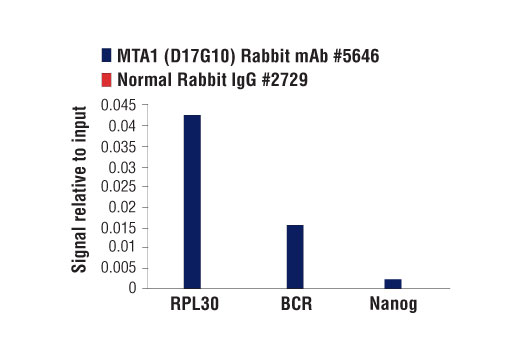WB, IP, ChIP
H M R Mk
Endogenous
78-82
Rabbit IgG
#Q13330
9112
Product Information
Product Usage Information
For optimal ChIP results, use 10 μl of antibody and 10 μg of chromatin (approximately 4 x 106 cells) per IP. This antibody has been validated using SimpleChIP® Enzymatic Chromatin IP Kits.
| Application | Dilution |
|---|---|
| Western Blotting | 1:1000 |
| Immunoprecipitation | 1:200 |
| Chromatin IP | 1:50 |
Storage
Specificity / Sensitivity
Species Reactivity:
Human, Mouse, Rat, Monkey
Source / Purification
Monoclonal antibody is produced by immunizing animals with a synthetic peptide corresponding to residues surrounding Val632 of human MTA1 protein.
Background
MTA1 (metastasis associated gene 1) was identified in a differential screening of a cDNA library of metastatic and nonmetastatic adenocarcinoma cell lines (1), and was subsequently found to be an integral member of the nucleosome remodeling and deacetylation (NuRD) complex (2,3). MTA1 expression is upregulated under hypoxic conditions and found to enhance angiogenesis through stabilization of HIF-1α (4,5). MTA1 is overexpressed in a wide range of human cancers, and its expression is associated with malignancy and tumor progression (6). MTA1 is an essential downstream effector of c-Myc transformation (7). Recently, MTA1 was demonstrated to play a role in DNA damage response (8,9).
- Toh, Y. et al. (1994) J Biol Chem 269, 22958-63.
- Xue, Y. et al. (1998) Mol Cell 2, 851-61.
- Zhang, Y. et al. (1998) Cell 95, 279-89.
- Yoo, Y.G. et al. (2006) EMBO J 25, 1231-41.
- Moon, H.E. et al. (2006) Oncol Rep 16, 929-35.
- Toh, Y. and Nicolson, G.L. (2009) Clin Exp Metastasis 26, 215-27.
- Zhang, X.Y. et al. (2005) Proc Natl Acad Sci U S A 102, 13968-73.
- Li, D.Q. et al. (2009) J Biol Chem 284, 34545-52.
- Li, D.Q. et al. (2010) J Biol Chem 285, 10044-52.
Species Reactivity
Species reactivity is determined by testing in at least one approved application (e.g., western blot).
Western Blot Buffer
IMPORTANT: For western blots, incubate membrane with diluted primary antibody in 5% w/v nonfat dry milk, 1X TBS, 0.1% Tween® 20 at 4°C with gentle shaking, overnight.
Applications Key
WB: Western Blotting IP: Immunoprecipitation ChIP: Chromatin IP
Cross-Reactivity Key
H: human M: mouse R: rat Hm: hamster Mk: monkey Vir: virus Mi: mink C: chicken Dm: D. melanogaster X: Xenopus Z: zebrafish B: bovine Dg: dog Pg: pig Sc: S. cerevisiae Ce: C. elegans Hr: horse GP: Guinea Pig Rab: rabbit All: all species expected
Trademarks and Patents
Limited Uses
Except as otherwise expressly agreed in a writing signed by a legally authorized representative of CST, the following terms apply to Products provided by CST, its affiliates or its distributors. Any Customer's terms and conditions that are in addition to, or different from, those contained herein, unless separately accepted in writing by a legally authorized representative of CST, are rejected and are of no force or effect.
Products are labeled with For Research Use Only or a similar labeling statement and have not been approved, cleared, or licensed by the FDA or other regulatory foreign or domestic entity, for any purpose. Customer shall not use any Product for any diagnostic or therapeutic purpose, or otherwise in any manner that conflicts with its labeling statement. Products sold or licensed by CST are provided for Customer as the end-user and solely for research and development uses. Any use of Product for diagnostic, prophylactic or therapeutic purposes, or any purchase of Product for resale (alone or as a component) or other commercial purpose, requires a separate license from CST. Customer shall (a) not sell, license, loan, donate or otherwise transfer or make available any Product to any third party, whether alone or in combination with other materials, or use the Products to manufacture any commercial products, (b) not copy, modify, reverse engineer, decompile, disassemble or otherwise attempt to discover the underlying structure or technology of the Products, or use the Products for the purpose of developing any products or services that would compete with CST products or services, (c) not alter or remove from the Products any trademarks, trade names, logos, patent or copyright notices or markings, (d) use the Products solely in accordance with CST Product Terms of Sale and any applicable documentation, and (e) comply with any license, terms of service or similar agreement with respect to any third party products or services used by Customer in connection with the Products.


